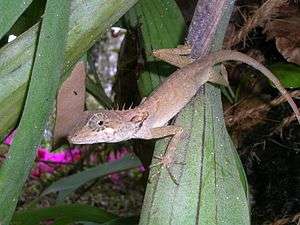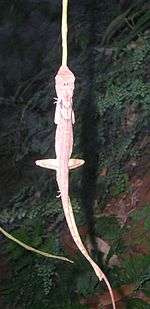Calotes rouxii
| Calotes rouxii | |
|---|---|
 | |
| Scientific classification | |
| Kingdom: | Animalia |
| Phylum: | Chordata |
| Class: | Reptilia |
| Order: | Squamata |
| Suborder: | Iguania |
| Family: | Agamidae |
| Genus: | Calotes |
| Species: | C. rouxii |
| Binomial name | |
| Calotes rouxii | |
Calotes rouxii, commonly known as Roux's forest lizard, is a species of arboreal, diurnal, agamid lizard, which is endemic to hills of peninsular India.
Etymology
The specific name, rouxii, is in honor of Jean Louis Florent Polydore Roux, who was a French painter and naturalist.[3]
Description

C. rouxii can attain a total length (including tail) of up to 30 cm (12 in), but 25 cm (9.8 in) is more common. Its body has an olive-brown color, with a lighter belly, a dark band along the side of the head on to the neck, and dark lines radiating from the eye. The limbs are slender, with elongated toes. Two small groups of spines adorn each side of the neck.[4][5] In males, the upper part of the head, nape, and gular pouch become brick-red in the breeding season.[6]
Distribution and habitat
Calotes rouxii is endemic to hills of peninsular India, including the Western Ghats from Surat Dangs till Palghat; and parts of the Eastern Ghats (Shevaroys, Yelagiri, Melagiri, and in Malkangiri, Araku, Devarakonda) and hills of Deccan plateau (Bellary, Sandur). It has been reported largely from the wet hill forest tracts of peninsular India, except the far south. The species is generally widespread and common throughout its range. It can be found at elevations of 100–900 m (330–2,950 ft) above sea level, in forest habitats ranging from moist evergreen to secondary deciduous forests.[1]
Ecology
C. rouxii is an insectivore, hunting during the day both on the ground and in trees.[1] It is oviparous, breeding between April and September.[6]
References
- 1 2 3 Srinivasulu B, Srinivasulu C, Vijayakumar SP, Ramesh M, Ganesan SR (2013). "Calotes rouxii". IUCN Red List of Threatened Species. IUCN. 2013: e.T172582A1346225. Retrieved 17 December 2015.
- ↑ Duméril AMC, Bibron G (1837). Erpétologie Générale ou Histoire Naturelle Complete des Reptiles. Tome quatrième [Volume 4]. Paris: Librairie Encyclopédique de Roret. 571 pp. + errata et emendanda. (Calotes rouxii, new species, pp. 407-408). (in French).
- ↑ Beolens, Bo; Watkins, Michael; Grayson, Michael (2011). The Eponym Dictionary of Reptiles. Baltimore: Johns Hopkins University Press. xiii + 296 pp. ISBN 978-1-4214-0135-5. (Calotes rouxii, p. 228).
- ↑ Günther ACLG (1864). The Reptiles of British India. London: The Ray Society. (Taylor and Francis, printers). xxviii + 452 pp. + Plates I-XXVI. (Calotes rouxii, p. 142).
- ↑ Smith MA (1935). The Fauna of British India, Including Ceylon and Burma. Reptilia and Amphibia. Vol. II.—Sauria. London: Secretary of State for India in Council. (Taylor and Francis, printers). xiii + 440 pp. + Plate I + 2 maps. ("Calotes rouxi [sic]", pp. 206-207).
- 1 2 Sreekar R, Saini K, Rao SN, Purushotham CB (2011). "Predicting lizard gender: sexual dimporhism in Calotes rouxii (Reptilia: Agamidae) from Agumbe, Karnataka, India" (PDF). Herpetological Conservation and Biology. 6 (1): 75–80.
External links
- "Calotes rouxii DUMÉRIL & BIBRON, 1837". The Reptile Database.
Further reading
- Boulenger GA (1890). The Fauna of British India, Including Ceylon and Burma. Reptilia and Batrachia. London: Secretary of State for India in Council. (Taylor and Francis, printers). xviii + 541 pp. (Calotes rouxii, p. 142).
- Ganesh, S. R.; M. Arumugam 2016. Species Richness of Montane Herpetofauna of Southern Eastern Ghats, India: A Historical Resume and a Descriptive Checklist Russ. J. Herpetol. 23 (1): 7-24.
- Das I (2002). A Photographic Guide to Snakes and other Reptiles of India. Sanibel Island, Florida: Ralph Curtis Books. 144 pp. ISBN 0-88359-056-5. (Calotes rouxii, p. 73).
